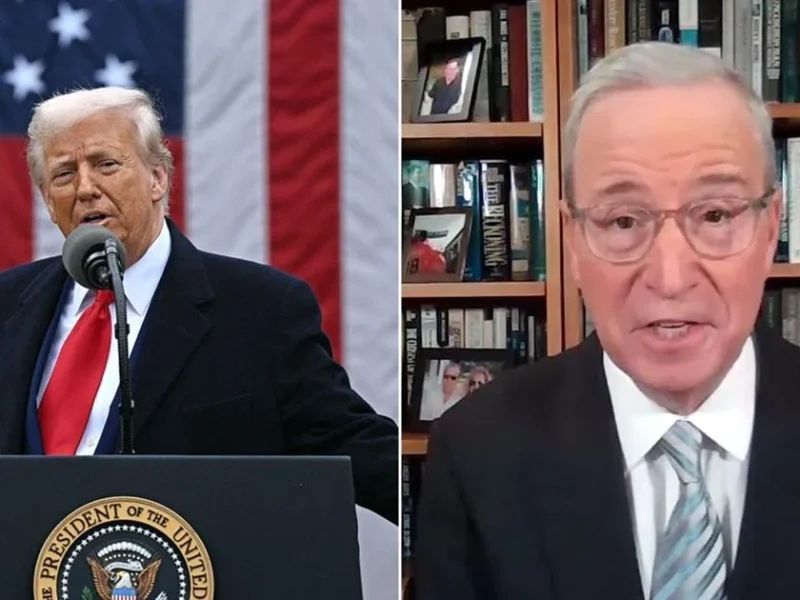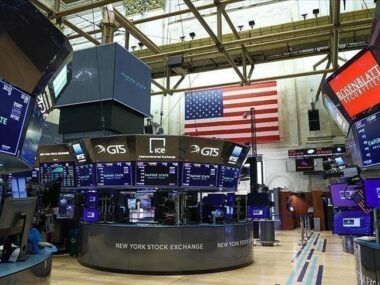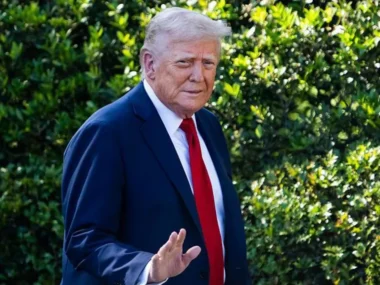In his first 100 days back in office, Donald Trump pushed an economy once admired globally to the edge of a crisis, threatening America’s standing as a financial stronghold and causing anxiety among voters who had lost trust in his leadership.
With Americans struggling with high grocery prices, many had hoped for relief from Trump’s promise to restore affordability by November 2024, fueled in part by nostalgia for the pre-pandemic economy of his first term.
However, the president purposely enacted policies likely to further escalate prices, create shortages, and leave both CEOs and small businesses grappling with instability and the threat of a recession. Trump is pushing for a radical transformation of both the US and global economies, insisting he can revive a mythical golden age from the late 19th century by using “beautiful” tariffs to assert US economic dominance and overpower trade competitors.

Shoppers at a grocery store in New York on April 1.
A president who has spent time golfing while workers’ 401(k)s have plummeted has often seemed detached from the growing concerns of Americans, from business leaders to everyday shoppers witnessing the effects of his policies during his first 100 days in office, which he will mark on Tuesday. Trillions of dollars have been lost in the stock markets. Airlines are reducing flights, major companies are downgrading their annual forecasts, and some retailers have stopped selling China-made goods in the US due to tariffs. The International Monetary Fund lowered US growth projections, and the Federal Reserve reported that some businesses have halted hiring. Walmart’s CEO warned Trump that his policies would disrupt the supply chain by summer. A potential recession is signaled by a sharp decline in consumer sentiment, which hit its fourth-lowest point since 1952 in April. CNN’s Fear and Greed Index, reflecting market emotions, has shown “fear” or “extreme fear” for the past month.
Consistently exerting American power.
Much like other actions since returning to the Oval Office, Trump’s trade policy is legally and constitutionally dubious, as he unilaterally declared a national emergency to gain powers for tariff warfare.
He’s now using vast and unchecked authority to test his long-held belief that the United States, the world’s wealthiest nation, has been exploited by other countries. His goal is to open foreign markets to US products and bring manufacturing jobs back to industrial regions hurt by the globalization of trade. Trump insists that numerous countries are eager to make US-friendly deals that will enrich Americans.
Millions of American jobs may be at stake in his gamble.
Trump is putting into practice a core belief that also underpins his efforts to dismantle the US-led Western political system, which has maintained global peace for 80 years: that the United States, the strongest global power, should not lead the world but should use its strength to negotiate one-on-one with smaller nations, coercing them into policies that benefit only America. This “America first” approach has already alienated many of America’s allies, though for a president who views life as a win-lose game, this is a feature, not a flaw.
The president’s volatile temperament and his belief that he has a sharper economic mind than those tasked with protecting jobs and controlling inflation also contribute to pushing the US economy to the brink.

President Donald Trump signs executive orders on tariffs in the Rose Garden at the White House in Washington, DC, on April 2.
Trump’s attacks on Federal Reserve Chairman Jerome Powell, for example, have damaged America’s reputation as a stable force in the global economy. Trump has been pushing for significant interest rate cuts, despite warnings from experts that this could drive inflation higher, which is already anticipated due to his tariffs. Markets have reacted negatively to his interference, which might explain why he’s, at least for now, backed off from his threats to fire the central bank chief.
Additionally, Trump is escalating a risky confrontation with China, launching a full-scale economic conflict with America’s 21st-century superpower rival, a move that carries significant geopolitical consequences beyond trade issues.
In an interview with Time magazine last week, marking his first 100 days, Trump said, “If you look at all of the years that I’ve been doing this, I’ve been right on things… You’re going to have the wealthiest country we’ve ever had, and you’re going to have an explosion upward in the not-too-distant future.”
What’s striking about the growing crisis is that it’s not caused by typical business cycles, external economic shocks, terrorist attacks, or natural disasters like pandemics. It’s all driven by an American president intentionally implementing tariff policies that almost all knowledgeable economic experts predict will lead to higher prices and reduced economic activity.
It’s not just the actions Trump is taking, but how he’s taking them.
He has imposed, paused, and adjusted tariffs unpredictably, generating the kind of uncertainty that can trigger recessions. In his Time interview, he claimed to have already completed 200 trade deals and stated that his team is negotiating with China, which is facing a 145% tariff that has effectively halted trade between the two nations. Beijing denies any ongoing contact with the US and shows no sign of yielding to his pressure.
Americans no longer trust Trump’s economic expertise.
Trump is taking an incredibly risky gamble.
“This is one of the most important days, in my opinion, in American history. It’s our declaration of economic independence,” the president declared, calling April 2 “Liberation Day” in the White House Rose Garden. He enthusiastically outlined tariff rates for numerous countries on large posters, stating, “We’re going to be wealthy as a country because they’ve taken so much of our wealth away from us.”
However, just hours after reciprocal tariffs were imposed, Trump unexpectedly paused them for 90 days, seemingly brought back to reality by unsettling activity in the bond markets that indicated investors were losing confidence in the US economy. Despite the reversal, his officials, loyal to Trump, praised the decision as evidence of his brilliance and predicted a flood of deals that would boost the economy. Yet, none of these deals have materialized.
The confusion and sudden shifts have been jarring for millions of Americans who hoped for economic relief, not another round of financial strain on family budgets.
After securing a plurality of the popular vote in November, Trump’s approval rating has dropped to 41%, the lowest of any president in his first 100 days in 70 years, according to a new CNN/SSRS poll. His approval on the economy—critical to his long-term political viability—has fallen to its lowest point at 39%. Only 35% approve of his handling of inflation, the same percentage that support his tariff policies.
Where are the agreements from the ‘ultimate dealmaker’?
The president’s weakening political standing is increasing pressure to deliver results that justify the significant disruption and harm he’s caused to the economy.
Despite this, the administration maintains that an economic strategy that seems to stem from the president’s personal impulses is actually a carefully crafted plan poised to succeed.
“He is the ultimate dealmaker,” Agriculture Secretary Brooke Rollins told CNN’s Dana Bash on State of the Union Sunday. “It’s going to be a new era of market expansion globally… Countries are knocking on our door right now.”
Treasury Secretary Scott Bessent framed Trump’s unpredictable leadership as a tactic to outsmart US trade adversaries.
“In game theory, it’s called strategic uncertainty. So, you’re not going to tell the person on the other side of the negotiation where you’re going to end up. And nobody’s better at creating this leverage than President Trump,” Bessent explained on ABC News’ This Week Sunday. “He’s shown the high tariffs, and here’s the stick. This is where the tariffs can go. And the carrot is, come to us, remove your tariffs, remove your non-tariff trade barriers, stop manipulating your currency, stop subsidizing labor and capital, and then we can talk.”

Shipping containers at the Port of Montreal in Montreal, Canada, on February 2.
If Trump’s tariff strategy succeeds and improves trading conditions for the United States, he will challenge the conventional wisdom of nearly every leading economic analyst and decades of US economic policy. However, if his actions push the country—and the global economy—into recession, there will be no political escape for him, as he has made himself the embodiment of the tariff policy.
This is why what happens next will be crucial to watch.
The administration predicts a wave of trade deals with countries like Japan, South Korea, and the European Union will soon unfold. However, given that such agreements typically take years to negotiate and require approval from foreign legislatures in democratic countries, it’s unlikely that these deals will match the sweeping global trade revolution the administration is anticipating. Nonetheless, Trump is likely to present any agreements as major achievements. Even if they fall short of transforming global trade, they might help calm markets, stabilize his political position, and reinforce his image as a master dealmaker.
Higher prices are on the way.
Even if Trump’s approach succeeds, it almost certainly means higher prices for Americans across the board, contradicting the message voters sent last November.
In his Time interview, Trump said he would view tariffs of 20%, 30%, or even 50% on foreign imports next year as a “total victory.” Such a scenario would lead to much higher prices for American consumers, effectively acting as a massive tax increase. Trump claims this will be offset by a significant tax reduction bill, but progress has been slow as GOP leaders work to push the plan through Congress.
While Trump argues that he has lowered prices for basic goods since taking office, that claim is largely false.
Trump’s view of himself as the mastermind behind the economy suggests even tougher times may lie ahead. For example, he has suggested that he would take sole responsibility for setting prices. “We are a department store, and we set the price,” Trump told Time. “Now, some countries may come back and ask for an adjustment, and I’ll consider that, but I’ll basically be, with great knowledge, setting.”
This arbitrary system, where one individual—especially someone with a basic understanding of economics like Trump—sets prices, could lead to chaos and corruption. It would also dismantle the rules-based economic system that has been central to making the US the world’s dominant power.
“The United States was more than just a nation. It’s a brand,” warned billionaire investor Ken Griffin at the Semafor World Economy Summit last week. “It was like an aspiration for most of the world. And we’re eroding that brand right now.”











